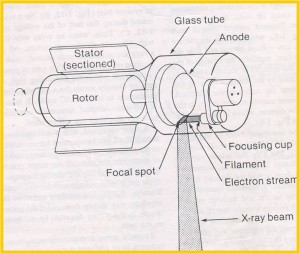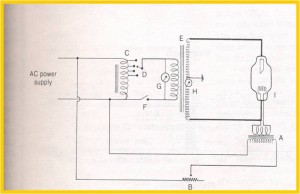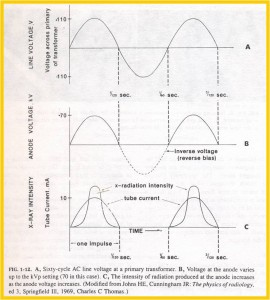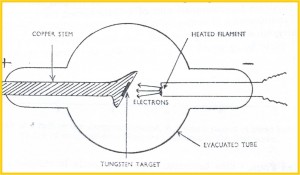The electrons move in this direction because of the strong electrical field between the negatively charged cathode & the positively charged anode.
The X- ray tube is evacuated completely as possible to fascilitate movement of these high speed electrons
Vacuum prevents:
Collision of moving electrons with gas mols- reduce the speed.
Prevents oxidation
Prevents burnout of the filament
ANODE
Target converts the kinetic energy of electrons generated from the filament into X- ray photons
Tungsten target
Thermal conductivity of tungsten is low , hence this target is embedded in large block of copper.
Cu, good thermal conductor, dissipates heat from the tungsten & Cu anode, reducing the risk of target melting
2 types of anode
Stationary
Rotating
STATIONARY ANODE
Tungsten target is embedded in a large block of Cu- good thermal conductor.
An insulating oil may circulate between the glass envelope & the protective tube housing.
The sharpness of the rad image increases as the size of the rad source, the focal spot, decreases.
Oblique angle of the target to the central ray, the effective focal spot size is much smaller than the actual focal spot size.
Heel effect-
Line focus principle-
Bragg effect
ROTATING ANODE
Dissipating heat from a small focal spot.
Tungsten target is in the form of a beveled disk that rotates when the tube is in operation
Arrangement of electrons strike target as it rotates- widens the focal spot by an amt corresponding to the beveled disk- distributes the heat to a larger area
X-ray tube with a rotating anode

POWER SUPPLY
FUNCTIONS:
Provides current to heat the X-ray tube filament –step down transformer
To generate a potential difference between the anode & cathode- high voltage transformer
These transformers & the X-ray tube lie within an electrically grounded metal housing- HEAD of the X- ray machine.
An electrical insulating material, oil, surrounds the transformers.
FILAMENT STEP DOWN TRANSFORMER
FUNCTIONS
Reduces the voltage of the incoming alternating current [AC] to about 10V.
Filament current control adjusts the current flow through the filament
Regulates the heating of the filament- quantity of electrons emitted
TUBE CURRENT- electron emitted by filament travel to the anode
mA setting on the filament current control- intensity of tube current – ammeter.
AUTOTRANSFORMER
Output is regulated by the kVp selector dial- selects varying voltages from different levels & then apply them across the high voltage transformer
Control the voltage between anode & cathode
HIGH VOLTAGE TRANSFORMER
Provide the high voltage required by the X-ray tube to accelerate the electrons & generate X-rays.
Boosting the voltage of the incoming line current from 60 to 100kV & the energy of the electrons passing through the tube from 60 to 100keV.
Dental x- ray circuitry with major components labelled

A-filament step down transformer
B-filament current control
C-autotransformer
D-kVp selector dial
E-high voltage transformer
F-x-ray timer
G-tube voltage indicator
H-tube current indicator
I-x- ray tube
Reverse bias -the intensity of x-ray pulses tend to be sharply peaked at the centre of each cycle.
In the following half of the cycle the AC reverses, filament becomes positive & target negative
Electrons stay at the filament & do not flow between the two elements of the tube. This is reverse voltage- NO X-RAYS.
Half wave rectifier/ self rectifer- alternating high voltage applied directly across the tube
Limits x-ray prodn to half the AC cycle
All conventional dental x-ray machines are self rectified.
Mechanism of X- ray production
High speed electrons are suddenly brought to rest.
Some of their kinetic energy converted into electromagnetic energy.
Original apparatus- source of electrons was the residual gas
These were accelerated by the applied voltage- rest- X-rays emitted.
Nowadays, electrons- electrically heated tungsten filament- rest – by a block of high atomic no.- X-rays produced.
This is the Coolidge tube-whole tube is evacuated- electrons suffer no loss of energy from filament to target
High voltage is applied between electrodes
Filament- cathode [negative]
Target- anode [positive]
Filament – heated – electrons emitted –repelled- attracted to target – rest
Passage of electrons from filament to target- acquired energy of electron [E]=product of charge [e] & voltage difference between electrodes
E=eV
Kinetic energy is surrendered to target
Then converted into energy forms- X-rays
THE RADIATION
X-rays coming from a tube – will not have one energy but constitute a complex spectrum.
Spectrum has two distinct parts- 2 different mechanisms:
Continuous spectrum
Line spectrum
Continuous spectrum
Containing all energies from a certain maximum downwards
Bremsstrahlung/ braking radiation
Slowing down of cathode stream electrons by the atoms of the target material
2 types of interactions [collisions]:
Impinging electrons interact with the electrons of the atom [electron cloud]
Electrons & the nuclei interact.

